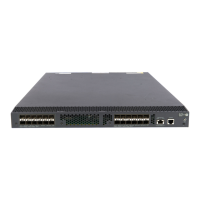182
Ste
Command
Remarks
3. Configure the port as a source
port for the specified remote
source group.
mirroring-group group-id
mirroring-port { both | inbound |
outbound }
By default, a port does not act as a
source port for any remote source
group.
Configuring the egress port for a remote source group
You can configure the egress port for a mirroring group in system view, or assign a port to it as the egress
port in interface view. The two configuration modes lead to the same result.
When you configure the egress port for a remote source group, follow these guidelines:
• Disable the following features on the egress port:
{ Spanning tree.
{ 802.1X.
{ IGMP snooping.
{ Static ARP.
{ MAC address learning.
• A mirroring group contains only one egress port.
• A port of an existing mirroring group cannot be configured as an egress port.
To configure the egress port for a remote source group in system view:
Ste
Command
Remarks
1. Enter system view.
system-view N/A
2. Configure the egress port for
the specified remote source
group.
mirroring-group group-id
monitor-egress interface-type
interface-number
By default, no egress port is
configured for a remote source
group.
To configure the egress port for a remote source group in interface view:
Ste
Command
Remarks
1. Enter system view.
system-view
N/A
2. Enter interface view.
interface interface-type
interface-number
N/A
3. Configure the port as the
egress port for the specified
remote source group.
mirroring-group group-id
monitor-egress
By default, a port does not act as
the egress port for any remote
source group.
Configuring the remote probe VLAN for a remote source group
You must first create a static VLAN before you configure it as a remote probe VLAN.
When you configure the remote probe VLAN for a remote source group, follow these restrictions and
guidelines:

